We’re now entering the “European” phase of the Bay Area International, with just one game a day for the last three rounds. (It’s a week-long tournament, with 1 game the first day, 2 the second, then 1-2-1-1-1.)
This is almost the first time that I have ever played in a tournament with one game per day for an extended period of time. (The only other ones I can remember are a couple of U.S. Opens where I played a 9-game, 6-day schedule.) Of course, most Americans grow up playing “weekend Swisses,” with five or six games crammed into two or three days. On a few occasions I have played in tournaments with a game a week, a format typical for chess club championships. But one game a day is new to me. It’s more leisurely than a weekend Swiss. It allows a player to be a human being rather than a human chessing. I have time today to catch up on e-mail, blogging, going to the gym, and even doing my regular work.
At the same time, one game per day gives me more of a sense of what it would be like to be a chess professional. Sitting down to play your game is like going to work for that day. Four or five hours, and then it’s over. Very civilized. Very European. Not very American. But I like it!
I didn’t mention the standings in my last post, so let me rectify that omission. The sixth round saw some exciting action, with Sam Shankland beating Bartlomiej Macieja of Poland in a Caro-Kann Defense, to pass him and move into a tie for first at 5-1. (Macieja had been the leader after the fifth round.) Board two was also decisive, as Anton Kovalyov beat Mackenzie Molner to also reach 5-1. This sets up a great showdown for round seven between Kovalyov and Shankland, the #1 and #5 seeds by rating.
There is a six-way tie for third at 4½-1½, with the only non-GM in the group being IM Darwin Yang. He is clearly leading the race for the under-2500 prize. The top under-2300 player so far is Brandon Ashe (2193), who is having the kind of tournament that tail-enders like me can only dream of. He got off to a shaky start, losing his first two games, but he has since come back with four wins in a row! In fact, he and Shankland are the only players in the tournament who have won four in a row.
In keeping with the theme of a more human chess tournament, I should not fail to mention the fact that I’ve seen a few familiar faces among the spectators. Gjon Feinstein and Mike Splane came by yesterday and watched some of the action. Also, grandmaster Vinay Bhat showed up yesterday. Although he still plays online and in the U.S. Chess League, he hasn’t played an over-the-board tournament since 2010. He was a little bit tempted by this one, but he didn’t want to have any two-game days. I guess he is a complete convert to the European style. Also, back in the first two days of the tournament, Damian Nash was assisting the TD’s. I vaguely remembered him because we played once about 15 years ago, but I also knew him as the “other player” in Brian Wall’s lifetime brilliancy (which appeared in Chess Life a couple months ago). He has since moved to Hawaii and hopes to get more chess activity going there. Finally, I saw Eric Fingal again, a class-A player from Santa Cruz who used to organize the Santa Cruz Cup tournaments, but who has been inactive in tournament chess since 2008 for personal reasons. I’m excited to see that he might be getting interested again.
And finally, to prove that the players are actual people instead of chess-playing machines, here are photos of my first six opponents.
Round one: John Bryant. Current score: 3½-2½. I like the way that the light bulb is lighting up over his head. “Aha! I see a great move! 1. e4 and White wins!”
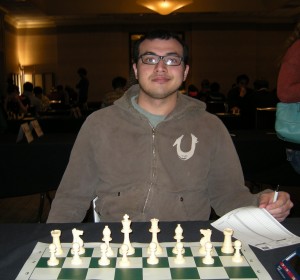 Round two: Leon Piasetski. Current score: 3½-2½. He’s from Canada, the only non-American that I have played so far. He came a few minutes late, so I’ve already played 1. d4, as you can see.
Round two: Leon Piasetski. Current score: 3½-2½. He’s from Canada, the only non-American that I have played so far. He came a few minutes late, so I’ve already played 1. d4, as you can see.
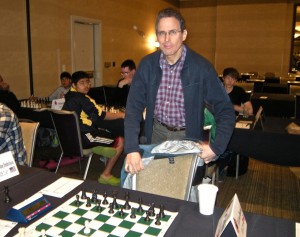 Round three: Hayk Manvelyan. Current score: 2½-3½.
Round three: Hayk Manvelyan. Current score: 2½-3½.
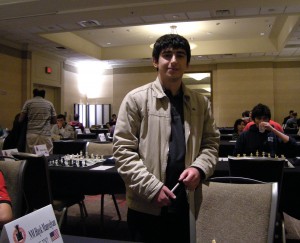 Round four: Raymond Kaufman. Current score: 3½-2½. He was the only player who offered to analyze our game after we finished. I found this very instructive. I went slightly astray as White in a Benoni, but still had a perfectly playable position. Kaufman showed me that I had to play a “Karpovian” move, h2-h3, a move that I never even considered. This might be a topic for a later blog post or maybe even a ChessLecture. Anyway, I very much liked his approach to the game and the analysis. He was less interested in the fact that he won and more interested in finding out the truth about the position.
Round four: Raymond Kaufman. Current score: 3½-2½. He was the only player who offered to analyze our game after we finished. I found this very instructive. I went slightly astray as White in a Benoni, but still had a perfectly playable position. Kaufman showed me that I had to play a “Karpovian” move, h2-h3, a move that I never even considered. This might be a topic for a later blog post or maybe even a ChessLecture. Anyway, I very much liked his approach to the game and the analysis. He was less interested in the fact that he won and more interested in finding out the truth about the position.
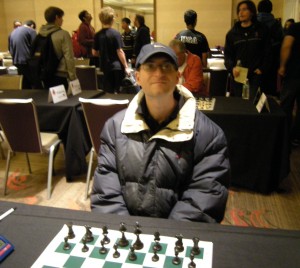 Round five: Bela Evans. Current score: 1-5. Tough tournament for him, obviously, and I’m sure that losing a probably won position against me didn’t make it any better. He still seems like a really nice guy, with a chess style that is perhaps a little bit too non-combative.
Round five: Bela Evans. Current score: 1-5. Tough tournament for him, obviously, and I’m sure that losing a probably won position against me didn’t make it any better. He still seems like a really nice guy, with a chess style that is perhaps a little bit too non-combative.
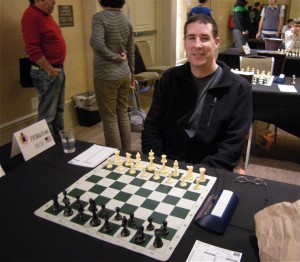 Round six: Steven Breckenridge. Current score: 3-3. My pregame photo of him was too blurry, but I am pretty sure that’s him in the upper right-hand corner of Ray Kaufman’s picture. (My resolution for round seven: Hold the camera steady.)
Round six: Steven Breckenridge. Current score: 3-3. My pregame photo of him was too blurry, but I am pretty sure that’s him in the upper right-hand corner of Ray Kaufman’s picture. (My resolution for round seven: Hold the camera steady.)
Breckenridge had one of the more crushing disappointments I’ve seen at this tournament, way back in round one. He was paired against the #1 seed, GM Anton Kovalyov (the same guy who is now tied for first in the tournament), as part of the regular round-one ritual of the lambs being led to slaughter. Except that somehow Breckenridge got what looked to me like a completely won position. He could win a pawn any time he liked, and had complete domination of the board. But instead of winning the pawn right away, he decided to try to “squeeze” the position in classic grandmaster style. Only it didn’t work. It gave Kovalyov time to organize a defense, and then suddenly there was a little tactic that won a pawn for Kovalyov, and before you knew it Breckenridge’s position had completely fallen apart. Just think how different the tournament would have been if Breckenridge had won that game. If… if… if… The saddest word in chess.



{ 3 comments… read them below or add one }
I was impressed/intimidated by the extent to which Ray Kaufman’s analysis of your game relied on prior knowledge, rather than general principles.
The “truth-seeking” attitude – I would hope that most chessplayers have that. It’s what I call “mathematician mind” rather than “lawyer mind.”
Yes, but that wasn’t what impressed me the most. It was the idea that I had to play this quiet move in what seemed like a wide-open position. You know me, I’m always wanting to charge into battle, but I had to realize that the position was in a dynamic balance, where the side to strike first will be at a disadvantage. So instead I should have taken the time to repair the weaknesses in my position. A pause to repair the lances and feed the soldiers before charging into battle again.
I find it challenging to play two games in one day, particularly in tournaments that last a few days. By the end of the last day, I feel mentally exhausted!
{ 1 trackback }